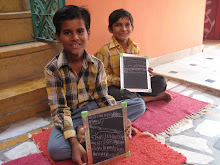Sunday, March 22, 2009
The Splatter Method of Discovery
Not too long ago, Anne Lamott wrote a terrific book called Bird by Bird: Some Instructions on Writing and Life. There are mounds of wisdoms packed into these pages, but the piece that lodged right into my brain is that any project, from folding a paper airplane to painting the Sistine Chapel, starts with a first fold, first brushstroke, first step.
I just got off the phone with Sarwar after an extended chat about education for toddlers. As I hash over our discussion, no clear narrative arc emerges, but rather a Jackson Pollock splatter of ideas, each bubbling and steaming with various degrees of possibilities. And this is how most innovations are launched in our desert classroom.
A chorus of pint-sized voices launches itself out of the peanut-gallery and into the spotlight: we want to learn how to use computers, our students say. So we began discussions about the whys and whats of computer literacy, got a few generous souls to donate some laptops and started one of the most popular pieces of our programming.
The method is that ANY idea is possible as long as you have the ears to listen, the heart to believe and the feet to take the first step. Of course many ideas do some serious shape-shifting en route to realization: The Merasi School Garden, a great dream of Afreen and Akram's, never fully materialized due to poor sunlight and soil quality. But what emerged in place of a flower bed was a plot of land for recess, home to kite construction and flying, chalkboard painting and elaborate paste and coloring projects.
Speaking from the podium at Stanford, Steve Jobs spoke about connecting the dots retrospectively. After we plunge passionately into our idea-realization, Sarwar and I work fiercely to distill replicable patterns and practices from our pilot projects and test runs and thus curricula emerge. But first, we swim in the alphabet soup, with the faith that there are enough vowels and consonants for the right words to rise to the top.
Sunday, March 1, 2009
The Joy Crisis
There are large, powerful schools of American educational theory that state bluntly: Our schools are in a state of CRISIS. This bold pronouncement is usually backed up by mountains of data amounting to spelling the word 'CRISIS' with flashing red lights while the theme from Schindler's List plays on repeat. And it's not without merit. One in three students will never graduate from high school and rural and urban schools across the country have become 8am-3pm dumping grounds from poor students who aren't developing the schools to meet basic literacy and math standards.
This depressing shovel is one way to dig into the issue of education. At The Merasi School, we have tried another approach. The Merasi have enough pre-determined obstacles in their path - living on .25 cents a day, being born without birth certificates, assigned the social worth of pollution- that we'd get plenty of nowhere by focusing on what education they don't have.
So we turned the tables and decided to focus on what they can do, have and be with education. By shifting from a framework of deficits to a framework of assets, the possibilities explode infront of the students like cherry blossoms in the DC spring. In its best form, education nurtures the raw potential that each student brings into the classroom and ripens it into its fullest expression. It is a fundamentally hopeful undertaking. It's something to be -- to use a word rarely associated with America's public schools -- joyful about it.
Most absolutely, the American educational institution is in need of serious attention. But it will not sustainably emerge from painting headlines with terrifying statistics about underperforming schools. Rather, I think that constructive change will be the product of families, educators and students developing bone-deep excitement about what can and must exist inside the classroom.
This depressing shovel is one way to dig into the issue of education. At The Merasi School, we have tried another approach. The Merasi have enough pre-determined obstacles in their path - living on .25 cents a day, being born without birth certificates, assigned the social worth of pollution- that we'd get plenty of nowhere by focusing on what education they don't have.
So we turned the tables and decided to focus on what they can do, have and be with education. By shifting from a framework of deficits to a framework of assets, the possibilities explode infront of the students like cherry blossoms in the DC spring. In its best form, education nurtures the raw potential that each student brings into the classroom and ripens it into its fullest expression. It is a fundamentally hopeful undertaking. It's something to be -- to use a word rarely associated with America's public schools -- joyful about it.
Most absolutely, the American educational institution is in need of serious attention. But it will not sustainably emerge from painting headlines with terrifying statistics about underperforming schools. Rather, I think that constructive change will be the product of families, educators and students developing bone-deep excitement about what can and must exist inside the classroom.
Subscribe to:
Posts (Atom)



